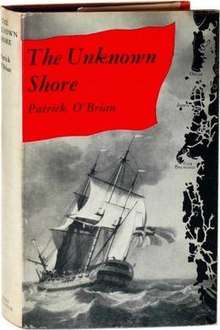The Unknown Shore
The Unknown Shore is a novel published in 1959 by Patrick O'Brian. It is the story of two friends, Jack Byron and Tobias Barrow, who sail aboard HMS Wager as part of the voyage around the world led by Anson in 1740. Their ship did not make it all the way around the world, unlike the flag ship. The novel is a fictionalised version of actual events which occurred during the Wager Mutiny.
 First edition (UK) | |
| Author | Patrick O'Brian |
|---|---|
| Country | United Kingdom |
| Language | English |
| Genre | Historical novel |
| Publisher | Rupert Hart-Davis (UK) & W.W. Norton (USA) |
Publication date | 1959 |
| Media type | Print (Hardback & Paperback) |
| Pages | 320 paperback |
| ISBN | 978-0-393-31538-7 W. W. Norton paperback edition 1996 |
| OCLC | 43224687 |
| Preceded by | The Golden Ocean |
Some reviewers feel that the midshipman Byron and the somewhat unworldly surgeon's mate Barrow are prototypes for Jack Aubrey and Stephen Maturin, who appear in O'Brian's Aubrey–Maturin series set in the Napoleonic Wars.
Plot summary
In the early part of the novel, set in London, other members of the expedition are featured. They appear in more detail in The Golden Ocean, another O'Brian novel about the Anson expedition.
The expedition is beset by storms while rounding of Cape Horn, the Wager is shipwrecked off the coast of Chile as their position could not be determined. The crew reject the authority of their officers, once the ship was wrecked and leave the captain, some officers and some other crew on the island when they sail away in a boat built from the wreck. The marooned officers make their way to a Spanish settlement with the help of the native people. The novel is based on the accounts of the survivors. Survivors from the lower deck made their way back to Britain long before the officers. The novel describes the crew members asserting that the officers had no authority over them, once their ship was wrecked.
Characters in The Unknown Shore
- Jack Byron – protagonist
- Tobias Barrow – "Jack's" friend
Allusions to real events, the shipwreck
The Wager's crew did reject the authority of their officers, once the ship was wrecked.[1] The lesson of the wreck of the Wager played a role in revising naval discipline, so that officers did retain formal authority over crew members, even when their ships were lost or captured.
Allusions to real persons
John "Jack" Byron was a historical person and the basic facts of the story are true. He went on to a distinguished naval career, rising to the rank of vice-admiral. There is an "easter egg" that O'Brian includes in the novel: his Jack Byron secretly writes poetry. He wants Tobias to refrain from mentioning it to any of his peers. The famous poet Lord Byron was one of John Byron's grandsons.
See also
- The Golden Ocean - another work by Patrick O'Brian, whose two protagonists are young men aboard one of the other vessels on the same expedition as the Wager.
References
-
"CHILE 2006". Scientific Exploration Society. 2006. Archived from the original on 7 January 2008. Retrieved 20 February 2008.
However, once ashore a dispute arose regarding the Captain's powers of command over the soldiers who had been aboard and the sailors who, once their ship was wrecked, were no longer paid by the Navy.